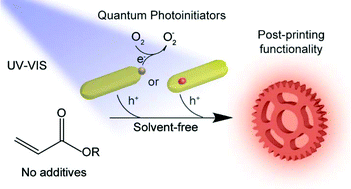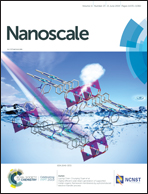A clear solution: semiconductor nanocrystals as photoinitiators in solvent free polymerization†
Abstract
Semiconductor nanocrystals have been shown to have unique advantages over traditional organic photoinitiators for polymerization in solution. However, efficient photoinitiation with such nanoparticles in solvent-free and additive-free formulations so far has not been achieved. Herein, the ability to use semiconductor nanocrystals for efficient bulk polymerization as sole initiators is reported, operating under modern UV-blue-LED light sources found in 3D printers and other photocuring applications. Hybrid semiconductor–metal nanorods exhibit superior photoinitiation capability to their pristine semiconductor counterparts, attributed to the enhanced charge separation and oxygen consumption in such systems. Moreover, photoinitiation by semiconductor nanocrystals overcoated by inorganic ligands is reported, thus increasing the scope of possible applications and shedding light on the photoinitiation mechanism; in light of the results, two possible pathways are discussed – ligand-mediated and cation-coordinated oxidation. A demonstration of the unique attributes of the quantum photoinitiators is reported in their use for high-resolution two-photon printing of optically fluorescing microstructures, demonstrating a multi-functionality capability. The bulk polymerization demonstrated here can be advantageous over solvent based methods as it alleviates the need of post-polymerization drying and reduces waste and exposure to toxic solvents, as well as broadens the possible use of quantum photoinitiators for industrial and research uses.

- This article is part of the themed collection: Advisory Board research selection


 Please wait while we load your content...
Please wait while we load your content...